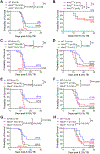Re-Examination of the Exacerbating Effect of Inflammasome Components during Radiation Injury
- PMID: 34855933
- PMCID: PMC8982344
- DOI: 10.1667/RADE-21-00142.1
Re-Examination of the Exacerbating Effect of Inflammasome Components during Radiation Injury
Abstract
Radiation can be applied for therapeutic benefit against cancer or may result in devastating harm due to accidental or intentional release of nuclear energy. In all cases, radiation exposure causes molecular and cellular damage, resulting in the production of inflammatory factors and danger signals. Several classes of innate immune receptors sense the released damage associated molecules and activate cellular response pathways, including the induction of inflammasome signaling that impacts IL-1β/IL-18 maturation and cell death. A previous report indicated inflammasomes aggravate acute radiation syndrome. In contrast, here we find that inflammasome components do not exacerbate gamma-radiation-induced injury by examining heterozygous and gene-deletion littermate controls in addition to wild-type mice. Absence of some inflammasome genes, such as caspase-1/11 and Nlrp3, enhance susceptibility of treated mice to acute radiation injury, indicating importance of the inflammasome pathway in radioprotection. Surprisingly, we discover that the survival outcome may be sex-dependent as more inflammasome-deficient male mice are susceptible to radiation-induced injury. We discuss parameters that may influence the role of inflammasomes as radioprotective or radioexacerbating factors in recovery from radiation injury including the use of littermate controls, the sex of the animals, differences in microbiota within the colonies and other experimental conditions. Under the conditions tested, inflammasome components do not exacerbate radiation injury, but rather provide protective benefit.
©2022 by Radiation Research Society. All rights of reproduction in any form reserved.
Figures


References
-
- Georgakilas AG, Pavlopoulou A, Louka M, Nikitaki Z, Vorgias CE, Bagos PG, et al. Emerging molecular networks common in ionizing radiation, immune and inflammatory responses by employing bioinformatics approaches. Cancer Lett. 2015;368(2):164–72. - PubMed
-
- McBride WH, Chiang CS, Olson JL, Wang CC, Hong JH, Pajonk F, et al. A sense of danger from radiation. Radiation research. 2004;162(1):1–19. - PubMed
MeSH terms
Substances
Grants and funding
LinkOut - more resources
Full Text Sources

